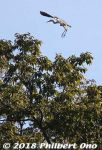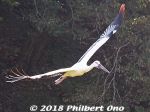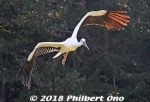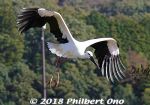 Image search results - "kounotori" Image search results - "kounotori" |

Hyogo Park of the Oriental White Stork has a few buildings amid large rice paddies and mountains.
|
|

Huge rice paddy within Hyogo Park of the Oriental White Stork.
|
|

Rice paddy has a high nesting platform. The nest still intact.
|
|

Spider web.
|
|

Kounotori can also mean "bird bringing happiness." Sculpture related to the bird of happiness. Makes people happy especially when the stork delivers your baby.
|
|

White stork mail box at Oriental White Stork Park in Toyooka, Hyogo.
|
|

Basic map of Hyogo Park of the Oriental White Stork. Only one building on the left is open to the public.
|
|

Gate to Hyogo Park of the Oriental White Stork. Open: 9:00 am–5:00 pm, closed Mondays (open if a national holiday and closed the next day instead), December 28th–January 4th.
|
|

The building in the middle is the University of Hyogo Graduate School of Regional Resource Management.
|
|

On the right is the park's administrative building.
|
|

On the left is the Toyooka Kounotori Bunkakan or Oriental White Stork Culture Center.
|
|

Inside the Oriental White Stork Culture Center. Walk through this building to the other side of the building to see the open cage.
|
|

Toyooka Oriental White Stork Culture Center's open cage for Oriental white storks. It includes paddies used for feeding. The cage is "open" because it only hasa fence and no roof.
|
|

Toyooka Oriental White Stork Culture Center's open cage for Oriental white storks. There are about nine storks in the open cage. Their wings have been clipped to they cannot fly.
|
|

So if you go to Hyogo Park of the Oriental White Stork, you can see real Oriental white storks.
|
|

About the Oriental white stork open cage.
|
|

Around 9:30 am to 10 am, they feed the storks. This is the best time to visit the park. And the best chances of seeing storks flying around.
|
|

They are throwing small dead fish into the paddies.
|
|

The storks are carnivores, feeding on fish, frogs, snakes, rabbits, mice, etc.
|
|

The Oriental white stork has black and white wings and a black bill.
|
|
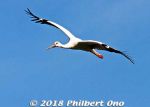
The Oriental white stork is a big, beautiful bird often mistaken as the Japanese crane. Wingspan is 2 meters.
|
|

Once found all over Japan, the Oriental white stork ("kounotori" in Japanese) became extinct in the wild in Japan in 1971 despite preservation efforts since 1955.
|
|

Toyooka was where the last living Oriental white stork in Japan died in 1986. Pesticides in rice paddies (where they feed) and other environmental problems caused their demise.
|
|

In 1985, six wild Oriental white stork chicks from the USSR (Khabarovsk) were acquired to be raised in Toyooka. From 1989, the birds from Russia started to breed successfully in captivity in Toyooka every year.
|
|

From 2005, the park started releasing Oriental white storks into the wild in Toyooka, which was a great celebration. The birds then started to breed and reproduce in the wild.They've been releasing only a few birds (fewer than 5) almost every year.
|
|

As of Oct. 2018, Japan has over 140 Oriental white storks in the wild. They are also successfully breeding in Tokushima, Shimane, and Kyoto Prefectures. It's still an endangered species, with only slightly over 2,000 of them in the Far East.
|
|
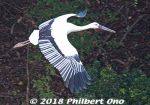
I didn't expect to see the storks flying around, so I was thrilled when a few of them flew overhead while I was in the park. They flew in during feeding time.
|
|
|
|
|
|
|
|
|
|
|
|

They make a loud clacking noise with their bills.
|
|
|
|
|
|
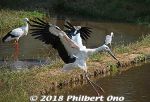
White stork landing in the paddy during feeding time.
|
|

Feeding time for the storks also attracts unwanted birds like black kites. They swoop in and steal a fish, then don't come back.
|
|

Grey herons also drop by, but they are always fighting each other.
|
|
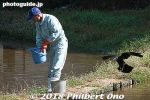
Crows also drop by.
|
|

Storks swallow the fish whole.
|
|
|
|
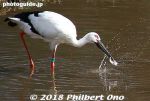
Oriental white stork eating a fish.
|
|

Landing on a nesting platform.
|
|
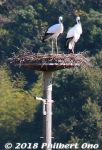
Two Oriental white storks on a nesting platform. Each nesting platform has a video camera monitoring it 24/7 especially during the egg-laying and hatching season in spring.The park is likely crowded during this time until the babies leave the nest in June/July.
|
|

Oriental white stork nests are large, about 2 meters diameter, made of tree branches and straw.
|
|

Back inside the Oriental White Stork Culture Center. On the left is the European white stork with a red bill, on the right is the Oriental white stork with a black bill. Very similar.
|
|

The hanafuda card with the "crane" is actually an Oriental white stork. It actually looks like a cross between the two birds...
|
|

Exhibits.
|
|
|
|
|
|
|
|
|
|
|

Screening room.
|
|

Aquariums with fish.
|
|

Even insects.
|
|

Part of the park is a large biotope used as a stork sanctuary and research facility. Only part of it is open to the public.
|
|
|

Nesting platform.
|
|

About the biotope.
|
|

Large biotope used as a stork sanctuary and research facility.
|
|

Park's website: http://www.stork.u-hyogo.ac.jp/en/
|
|

Gift shops in this building next to the parking lot.
|
|

Confection shaped like stork eggs.
|
|

Oriental White Stork manhole in Toyooka, Hyogo Prefecture.
|
|

Oriental White Stork manhole in Toyooka, Hyogo Prefecture.
|
|

Airline with a plane donning an Oriental White Stork motif.
|
|
|
|
|
|
|



























